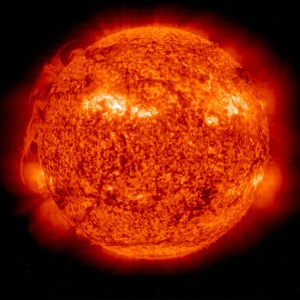Today I was thinking about stars. Because…well, doesn’t everybody? So I did a little reading to brush up on my knowledge of the life cycle of the star. Since we see so many stars in the sky, we may think of them as commonplace. But some pretty extraordinary stuff happens during a star’s lifetime.
Baby Stars
A star is born when a large cloud (light years across) collapses under its own gravity. Very cold temperatures soon warm up as atoms “fall” toward the center, growing closer together and rubbing against each other. Some of the generated heat remains trapped inside. The temperature and pressure ignite nuclear reactions.

Orion Nebula: a nursery of stars, Credit: http://en.wikipedia.org/wiki/Star_formation#mediaviewer/File:Orion_Nebula_-_Hubble_2006_mosaic_18000.jpg
Active Stars
The nuclear reactions produce fusion. The star works at turning hydrogen into helium. It produces energy. All the heat and light we receive from the sun come from these fusion reactions.

Our Sun, Credit: http://www.8planets.co.uk/facts-about-the-sun
Dying Stars
Eventually a star runs out of hydrogen to burn. When this happens, a variety of deaths await the star – depending on its size. Smaller stars “burn out,” cool down, shed outer layers (such as the red giant shedding a new nebula seen below.) Larger stars end in supernovae explosions, sometimes forming black holes.

Red giant star shedding out layers, Credit: http://d1jqu7g1y74ds1.cloudfront.net/wp-content/uploads/2007/10/2007-1023chandra.jpg

Lifecycle of a Star, Credit: http://www.schoolsobservatory.org.uk/astro/stars/lifecycle



